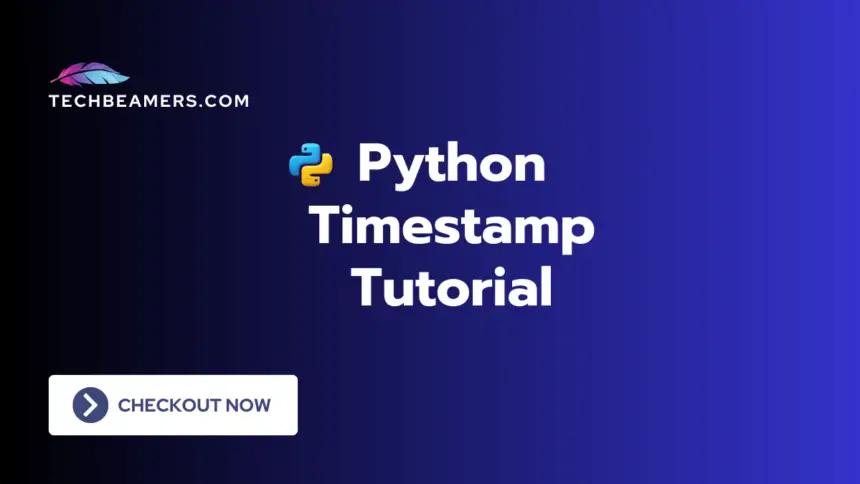In Python, a timestamp is like a timestamp! It’s a number that tells you when something happened. This guide will help you get comfortable with timestamps in Python. We’ll talk about how to make them, change them, and why they’re useful.
Getting Started with Timestamp in Python
A timestamp is just a way of saying, “Hey, this happened at this exact moment.” It’s like marking time from a certain starting point. For us, that starting point is often January 1, 1970. Computers use timestamps a lot to keep track of when things occur.
Get Timestamps in Python
In Python, getting timestamps involves fetching the current time or converting existing time into timestamp format. Let’s explore different ways to get it:
Also Read: Python Get the Current Timestamp
Using the time Module
The time module is like your timekeeping buddy. It helps you figure out what time it is right now.
import time as tm
timestamp = tm.time()
print("Right Now:", timestamp)Using the datetime Module
The datetime module is like the fancier version of time. It also helps you know what time it is but in a more human-friendly way.
from datetime import datetime as dt
timestamp = dt.now().timestamp()
print("Current Time:", timestamp)Using timeit Module
The timeit module is handy for measuring the execution time of code snippets. While not directly for timestamp retrieval, it provides a way to gauge the time taken for a specific operation.
import timeit
start_time = timeit.default_timer()
# Your code or operation here
end_time = timeit.default_timer()
elapsed_time = end_time - start_time
print("Elapsed Time:", elapsed_time)By measuring the time taken for a code block, you indirectly obtain a sense of time duration.
Using PYTZ for Timezone-Aware Timestamps
When working with timestamps in different time zones, the pytz library is useful. It allows you to create timezone-aware datetime objects and extract timestamps.
from datetime import datetime as dt
import pytz
timezone = pytz.timezone('America/New_York')
aware_time = dt.now(timezone)
timestamp = aware_time.timestamp()
print("Timestamp in New York:", timestamp)Here, we use pytz.timezone to create a timezone object and then get the timestamp for the current time in that timezone.
Using Custom Functions
If you need a timestamp with higher precision, you can create a custom function using the time module.
import time as tm
def get_correct_tm():
return tm.time_ns() / 1e9 # Nanoseconds to seconds
timestamp = get_correct_tm()
print("Correct Timestamp:", timestamp)The time_ns() function returns the current time in nanoseconds, providing higher precision than seconds.
Convert Timestamps
In Python, you can convert timestamps between different representations using the datetime module. The datetime module provides a datetime class that can be used to represent dates and times. Here’s a guide on how to convert timestamps in Python:
From Timestamp to Regular Time
If you have a timestamp and want to know when it happened in regular words, you can do that too!
from datetime import datetime as dt
timestamp = tm.time()
regular_time = dt.fromtimestamp(timestamp)
print("Happened at:", regular_time)From Regular Time to Timestamp
You can also go backward! If you have a normal time, you can turn it into a timestamp.
from datetime import datetime as dt
regular_time = dt.now()
timestamp = regular_time.timestamp()
print("Turned into Timestamp:", timestamp)Timestamp Operations in Python
In Python, you can do operations on timestamps like addition or getting the time difference. Here are some common timestamp operations in Python:
Adding Time
You can even mess around with time. Wanna know what the date and time will be one day from now? Easy!
from datetime import datetime as dt, timedelta
timestamp = tm.time()
time_now = dt.fromtimestamp(timestamp)
one_day_later = (time_now + timedelta(days=1)).timestamp()
print("One Day Later:", one_day_later)Making Time Look Pretty
Timestamps can look a bit clumsy. You can make them look nice and readable!
from datetime import datetime as dt
timestamp = tm.time()
time_now = dt.fromtimestamp(timestamp)
pretty_time = time_now.strftime("%Y-%m-%d %H:%M:%S")
print("Nice-looking Time:", pretty_time)Get the Time Difference
Find the difference between two timestamps to measure the duration between two points in time.
from datetime import timedelta as td
tm1 = 1611064264 # Replace with your first timestamp
tm2 = 1611164264 # Replace with your second timestamp
time_diff = td(seconds=tm2 - tm1)
print(time_diff)
#Output 1 day, 3:46:40Comparing Timestamps
Compare two timestamps to determine their chronological order (which one occurred earlier or later).
is_earlier = tm1 < tm2
is_later = tm1 > tm2These operations enable you to work with time-related data in various use cases, such as calculating durations, making timestamps prettier, and also, comparing different points in time.
Smart Tips
Knowing Timezones
Sometimes, it’s crucial to know where something happened. Use the pytz library for that.
from datetime import datetime as dt
import pytz
utc_now = dt.now(pytz.utc)
print("Timestamp in UTC:", utc_now.timestamp())No More Confusion with Decimals
Computers can be weird with numbers. To avoid confusion, use whole numbers for a really precise time.
Wrapping Up
Getting the hang of Python timestamps is like having a superpower. It helps you understand when things are happening in your code. So, go ahead, play with timestamps, and make time work for you in your Python projects! Enjoy coding!









